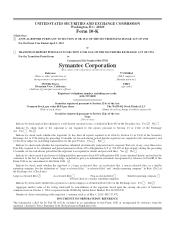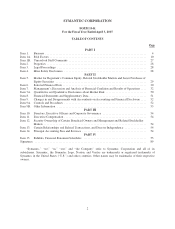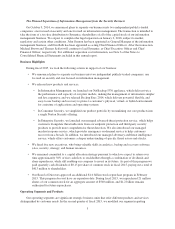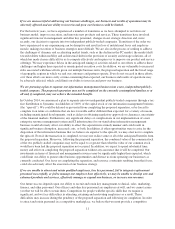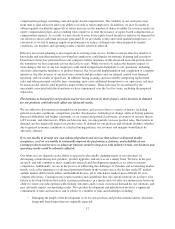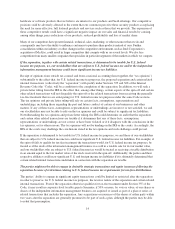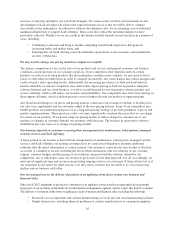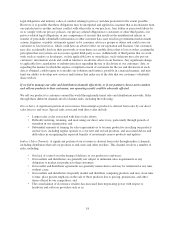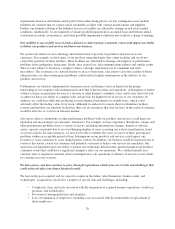Symantec 2015 Annual Report Download - page 89
Download and view the complete annual report
Please find page 89 of the 2015 Symantec annual report below. You can navigate through the pages in the report by either clicking on the pages listed below, or by using the keyword search tool below to find specific information within the annual report.If we are unsuccessful at addressing our business challenges, our business and results of operations may be
adversely affected and our ability to invest in and grow our business could be limited.
For the last few years, we have experienced a number of transitions as we have attempted to revitalize our
business model, improve execution, and innovate new products and services. These transitions have involved
significant turnover in management and other key personnel, changes in our strategic direction and, more
recently, our decision to separate into two independent publicly-traded companies. Transitions of the order we
have experienced or are experiencing can be disruptive and result in loss of institutional focus and employee
morale, making execution of business strategies more difficult. We are also in the process of seeking to address
the challenges of dynamic and accelerating market trends, such as the decline in the PC market, the market shift
towards tablets within mobility and architectural shifts in the provision of security and storage solutions, all of
which has made it more difficult for us to compete effectively and requires us to improve our product and service
offerings. We may experience delays in the anticipated timing of activities related to our efforts to address these
challenges and higher than expected or unanticipated execution costs. In addition, we are vulnerable to increased
risks associated with these efforts given our multiple business units, the proposed separation and the broad range
of geographic regions in which we and our customers and partners operate. If we do not succeed in these efforts,
or if these efforts are more costly or time-consuming than expected, our business and results of operations may
be adversely affected, which could limit our ability to invest in and grow our business.
We are pursuing a plan to separate our information management business into a new, independent publicly-
traded company. The proposed separation may not be completed on the currently contemplated timeline or at
all and, if completed, may not achieve the intended benefits.
In October 2014, we announced a plan to separate into two independent publicly-traded companies through a tax-
free distribution to Symantec stockholders of 100% of the capital stock of our information management business
(the “spin-off”). We could be delayed or prevented from completing the proposed separation, or be forced to
complete it on terms or conditions that are less favorable and/or different than expected, for a variety of reasons,
including unanticipated developments, such as delays in obtaining regulatory approvals or clearances, uncertainty
of the financial markets. Furthermore, any significant delays or complications in our implementation of a new
enterprise resource management system and IT infrastructure for our stand-alone information management
business would adversely affect our ability to effect the separation in a timely manner and could result in
significant business disruption, increased costs, or both. In addition, if other opportunities were to arise for the
disposition of the information business that we believe are superior to the spin-off, we may elect not to complete
the spin-off. Even if the transaction is completed, we may not realize some or all of the anticipated benefits from
the proposed separation. Moreover, following the proposed separation, the combined value of the common stock
of the two publicly-traded companies may not be equal to or greater than what the value of our common stock
would have been had the proposed separation not occurred. In addition, we expect to spend substantial time,
money and effort on completing the proposed separation without any assurance that it will be completed. Our
investments in terms of financial and management resources may be significantly higher than expected, which
could limit our ability to pursue other business opportunities and distract us from operating our businesses as
currently conducted. Our focus on completing the separation, and resource constraints resulting from that focus,
could also adversely affect the execution of our business strategy.
If we are unable to attract and retain qualified employees, lose key personnel, fail to integrate replacement
personnel successfully, or fail to manage our employee base effectively, we may be unable to develop new and
enhanced products and services, effectively manage or expand our business, or increase our revenues.
Our future success depends upon our ability to recruit and retain key management, technical, sales, marketing,
finance, and other personnel. Our officers and other key personnel are employees-at-will, and we cannot assure
you that we will be able to retain them. Competition for people with the specific skills that we require is
significant, and we face difficulties in attracting, retaining and motivating employees as a result. These
difficulties may increase during the pendency of the proposed separation and following its completion. In order
to attract and retain personnel in a competitive marketplace, we believe that we must provide a competitive
11


